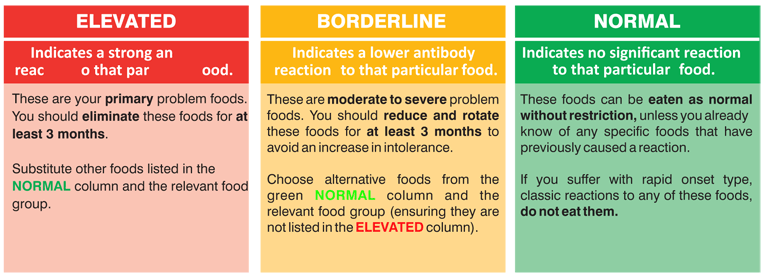- If there are no foods in the ELEVATED column, then the BORDERLINE foods should be avoided for 3 months.
- To rotate foods, you need to eat them no more than once every 4-5 days as the digestive process takes up to three days.For example, to rotate wheat, you could have wheat bread on day 1; oat cakes on day 2; corn cakes on day 3; rye crispbread on day 4; durum wheat pasta on day 5 etc.
- It can be difcult to eliminate many foods at one time. You may nd it easier to:
- completely avoid the top 4 or 5 foods showing the highest antibody concentrations
- reduce and/ or rotate the remaining foods showing lower antibody concentrations
- You may feel worse for a few days after eliminating a food. This is your body dealing with the changes and is experiencing withdrawal symptoms. Be prepared to persevere, as improvements may only become apparent anything from a few days to a few weeks into the diet.
- It is essential that if you cut out a food group, eg milk, you obtain nutrients found in this food (eg calcium) from other foods.
- Do not eliminate one food and substitute solely with another food as you are likely to build intolerance to that food. For example, if you cut out wheat at breakfast, do not swap to porridge oats every day.
- Many people have experienced the greatest improvement when completely eliminating the reactive foods. However, do not worry if you cannot completely eliminate these foods or you need to break your diet occasionally. Just start again as soon as you are able to.
- If one has been avoiding a food for more than 3 months then it is likely to show a NORMAL reaction.
- If, after changing your diet according to your test results, no improvement has been achieved, then food IgG intolerance may not be the cause and it is recommended that you seek advice from a qualied doctor/ healthcare professional.
- Gliadin is a protein found in gluten which is present in the grains of wheat, barley and rye. Due to the nature of our Food Intolerance Test, gliadin is tested separately from these grains. If your test shows a positive response to gliadin, the patient is advised to avoid, wheat, barley and rye containing foods even if these grains are in the green/NORMAL column of your report.
Food Intolerance Test
The terms food allergy, food intolerance, food sensitivity, hypersensitivity are often used interchangeably, and are often confused, but essentially they all mean an abnormal reaction to certain foods which can manifest themselves in a number of ways.
Scientically, the reactions can be differentiated by the fact that some cause an immune response, whereas others do not.
Food Intolerance Test helps to differentiate the reactions which cause immune response rather than confusing them with interchangeable terms such as food allergy, food intolerance, food sensitivity and hypersensitivity.

Reactions producing an Immune Response
The reactions that trigger an immune response are most often referred to as allergies. The most common ones are categorized as follows:
• Type I (IgE reaction)
This is also known as an IgE mediated allergy, Type I hypersensitivity reaction, ‘true’ or ‘classical’ allergy. Such a food allergy produces an immediate adverse reaction; i.e. within seconds or minutes after ingestion of certain foods (for example peanuts and shellfish) and produces symptoms such as rashes, sneezing, difficulty in breathing, and for some people can even be life threatening because of an anaphylactic shock.It is usually obvious which foods are responsible for a food allergy and these have to be avoided for the rest of your life.
lgE medicated allergy, Type I hypersensitivity reaction, true or classical allergy are food allergies which occurs as an immediate adverse reaction i.e. within seconds or minutes of consuming foods such as pea nuts, shell fish etc producing symptoms such as rashes, sneezing, difficulty in breathing and in some cases life threatening due to an anaphylactic shock. Avoiding such foods for the rest of life can prove beneficial.
• Type III (IgG reaction)
This is also known as IgG mediated reaction, Type III allergy, delayed onset, hypersensitivity / food sensitivity, however it is more commonly referred to as food intolerance. This is the type of reaction that is measured in your Food Intolerance Test.
Food intolerances are associated with a range of symptoms that are caused by chronic inflammatory processes. The onset of symptoms is within hours or days after ingestion of the food. Symptoms include anxiety, depression, IBS, headaches/ migraines, fatigue, hypertension, eczema, hypothyroidism, asthma, joint pain, chronic rhinitis, arthritis, weight problems and bromyalgia.
The good news is that with a food intolerance, it is possible to eliminate the food from the diet for a period of time and then to re-introduce them gradually back into the diet after an improvement in symptoms.
Reactions that do not produce an Immune Response
Those reactions that do not produce an immune response are most often referred to as intolerances. An example of this type of reaction is an enzyme deficiency such as :
Lactose intolerance which is due to a deficiency of the enzyme lactase. Symptoms include bloating, excessive wind, diarrhoea and stomach pains.
Histamine intolerance which is due to the deficiency or inhibition of the enzyme diamine oxidase, DAO. Symptoms include migraines, headaches, dizziness, bowel/ stomach problems, rhinitis, depression, irritation or reddening of the skin. Foods containing histamine include red wine, cheese, tuna fish or chocolate and citrus fruits.
Food Intolerance Test results are shown as ELEVATED , BORDERLINE or NORMAL and the concentration of IgG antibodies (in U/ml) is shown in brackets after each food.

